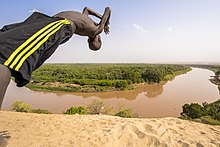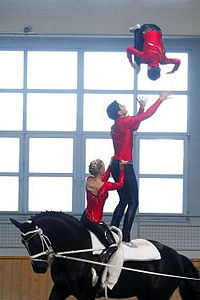Somersault (jump)
The somersault ( Italian jump; plural : somersaults or somersaults) is an element of different sports and describes a free flip around the transverse axis of the body .
execution
Forward somersault
Acrobatic exercises with somersaults are already documented from antiquity with corresponding pictures on vases. The biomechanics of the jumps, especially the different somersaults, was first described and analyzed by Archangelo Tuccaro (1599). The acrobatic execution of the somersault is considered relatively easy. A run-up, then a small jump forward to get some momentum, and now the arms are thrown down in front of the body. It will jump off as soon as you are about to stand upright. The legs should be pulled as far as possible and also pushed a little apart so that the jumper does not accidentally hit his nose with his knee.
One variant is the salto long jump, where a large jump distance is important.
Learning and practicing the forward flip implies risk of injury. At the beginning you don't have a feel for the landing and often stretch your legs too early or too late. Small people find the somersault easier than tall people; they have a more favorable “force to mass” quotient. Similarly, slim people find it easier than fat people. Young people have more elastic bones than older people. The harder the ground, the greater the deceleration forces when landing. There is a sprung floor in gyms ; this dampens the landing somewhat. Lawn on sports fields does not significantly dampen landing.
Somersault backwards
The backflip is considered to be easier than the forward somersault because of its sequence of movements; regardless of that, many find it difficult to jump “backwards”. The athlete jumps off on both legs with a slightly bent upper body and at the same time swings his arms behind his head. The body is brought into the back position with the movement of the arms. During the subsequent climbing phase of the body, the head is fixed in the extension of the spine, and the arms are also fixed behind the head. Towards the end of the gain in height, the legs are tucked in and the body rotates around the axis of rotation . The landing is initiated by opening the legs and hips back and down and stretching the arms diagonally forward. If you haven't turned fast enough, you land in the front position and can usually cushion the landing with your arms.
sports
There are different shapes and variations of somersaults, for example somersaults with several screws in gymnastics or multiple somersaults when jumping in the water. Rolls over are performed in various sports .
Sports in which humans do the somersault:
- Gymnastics
- Trampoline exercise
- Diving
- Vaulting
- Rock and roll
- Breakdance
- Cheerleading
- Free running
- Capoeira
- Tricking
Sports in which the person hits the somersault with a piece of sports equipment:
Related exercises
An exercise related to the somersault is the flick-flick . In aerobatics, the looping is comparable to the somersault.
Mortale and Nullo
- A somersault mortale (death jump) is a variant of the somersault often shown on the trapeze in a circus, in which a multiple, usually three or even fourfold flip is performed. The first person who can be shown to do a somersault on the trapeze was Jules Léotard .
- As a salto nullo (from zero to nothing) athletes and sports reporters jokingly refer to the missed qualification of jumping competitions ( pole vault , long jump , triple jump and the like) in competitions due to a three failed attempt.
Individual evidence
- ^ Trois Dialogues de l'exercise de Sauter et Voltiger en l'air; Avec the figures. Chez ^ Claude ^ de Monstr'œel, Paris 1599.
- ↑ Arnd Krüger , John McClelland: The Beginnings of Modern Sports in the Renaissance. (= Articles and sources on sport and society. Volume 2). Arena Publ., London 1984, ISBN 0-902175-45-9 .
- ↑ David Kirk, Robin Burgess-Limerick, Michael Kiss, Janine Lahey, Dawn Penney: Senior Physical Education: An Integrated Approach , Verlag Human Kinetics, 2004, ISBN 9780736052085 , p. 63 [1]
literature
- Flavio Bessi: Materials for trainer training in apparatus gymnastics - first license level. 3rd, modified edition. Self-published, Freiburg 2009, ISBN 978-3-00-027421-3 .
swell
- Christian Peiler, Dennis Peiler : Optimal vaulting training. 555 exercises and methods from popular to professional sports. 2nd, revised edition. FNverlag, Warendorf 2006, ISBN 3-88542-452-5 , p. 189.
- Sports Multimedial: Crouched back somersault , accessed on November 22, 2011
Web links
- Current sports knowledge: Floor exercise - somersault forward , accessed on November 22, 2011




